wheel AUDI S3 2009 Owners Manual
[x] Cancel search | Manufacturer: AUDI, Model Year: 2009, Model line: S3, Model: AUDI S3 2009Pages: 324, PDF Size: 76.02 MB
Page 5 of 324

Braking .... ....... ... ..... ... .
E lectro -mechanical power assist .
Driving with your quattro® ..... .
Driving and enviro nment ..... .
The first 1,000 mi les (1,500 km) and
afterwards ................... .
Cata lytic converter .......... .. .
Avoid damaging the vehicle .... .
Ope rate your vehicle economically
and minimize pollution ........ .
Trailer towing ........... ...... .
Driv ing with a trailer ..... ...... .
Trailer tow ing tips ....... ... ... .
Vehicle care ... .......... . .
193
195
196
197
197
198
199
199
202
202
204
206 Tire pressure monitor ing
system* ....................... .
Genera l notes (l) ........ .• .. ... .
Introduct ion .................. .
Sign ifican t loss of air pressure
(l) .
Storing tire pressures .. ... ... .. .
Whee l cha nge .......... ....... .
Malfu nct io ns TP MS* ........... .
Cert ificat ion
Do-it-yourself service
W hat do I do now? ... ......... .
Jack, too ls and spare wheel .... .
Compact spare wheel .......... .
W hee l cha nge ... ... ... .. .. .. .. . 264
264
264
265
266
267
267
268
270
270
270
271
2
7 2
Table of contents
Weights . . . . . . . . . . . . . . . . . . . . . . . . 299
Dimensions . . . . . . . . . . . . . . . . . . . . 299
Data ............................ 300
200 hp, 2.0 liter 4-cyl. tu rbo eng ine 300
250 hp, 3.2 liter 6 -cyl. engine . . . . . 302
Co nsumer Info rma tio n ......... 303
Wa rranty cove rages . . . . . . . . . . . . . 303
Operating your vehicle outside the
U.S.A. or Canada . . . . . . . . . . . . . . . . 303
Audi Service Repair Manuals and
Li terature . . . . . . . . . . . . . . . . . . . . . . 303
Maintenance . . . . . . . . . . . . . . . . . . . 304
Additional accessories,
mod ifications and parts
rep lacemen t . . . . . . . . . . . . . . . . . . . . 305
Cleaning and protection . . . . . . . 206 Fuses and bulbs . . . . . . . . . . . . . . . 280 Alphabetical index ...... 308
Genera l info rmation ........... .
Care of exterior . ... ... .. .. ... . .
Care of interior ................ .
Fuel supply and fil ling your fue l
ta nk ........................... .
Gasoline ......... .. .... ...... .
Fuel tank ..... .......... ...... .
Checki ng and filling .. ........ . .
Engine hood .................. .
Engine compartment .......... .
Engine oil ............... ..... .
E ngine cooling system ......... .
Brake fluid ............... ..... .
Battery ....................... . 206
2
06
213
2 19
2 19
220
224
224
226
227
2 32
235
236
W indshield washer container . . . . 241
Tires and wheels
Tires ... ...... ..... ... ·. · · · · · · ·
Controls and equip
ment Safety first
243
243 Fuses . .
. . . . . . . . . . . . . . . . . . . . . . . 280
B ul bs . . . . . . . . . . . . . . . . . . . . . . . . . 28 5
Emergency situations . . . . . . . . . . 287
Genera l . . . . . . . . . . . . . . . . . . . . . . . . 287
Sta rting by pushing or towing . . . 287
Start ing with jumper cables . . . . . 287
Genera l information of sta rting
ass istance . . . . . . . . . . . . . . . . . . . . . 288
Use of jumper cab les (4 cylinder
eng ine) . . . . . . . . . . . . . . . . . . . . . . . . 289
Use of jumper cables (6 cylinder
engine) . . . . . . . . . . . . . . . . . . . . . . . . 290
Emergency towing with commercia l
tow truck . . . . . . . . . . . . . . . . . . . . . . 292
Lifting the vehicle . . . . . . . . . . . . . . 295
Technical data
General information
298
298
Explanation of technical data . . . . 298
Vehic le ide ntif ication . . . . . . . . . . . . 298
Vehicle operation Vehicle care Do-it-yourself service Technical data
Page 9 of 324

Instruments and controls
General illustration
G)
0
©
©
©
©
0
©
®
Power window switches
Door handle
Power locking switch
Switches for:
- Adjuster for outside mirrors .. ........ ... ...... .
- Switching on heated exterior mirrors
Light switch .................................. .
Air outlets .... .... ... .. ............... ........ .
Turn signa l and high beam ...... ............. .. .
Radio control buttons
Steering wheel with:
- Integra ted control buttons (multi -function steering
wheel only) for Audi Sound System
-Horn
- Driver's airbag .............................. .
@ Instrument cluster .................... ...... ... .
@ Radio and telephone control buttons
@ Switches for
- Windshield wiper/washer .... ... .. ...... ... ... .
- Trip computer .... ................... ....... .
@ Depending on options: Radio or Navigation system
(navigation, radio, CD changer)
@ Switches for:
- Electronic Stabilization Program (ESP) .......... .
- Tire pressure monitoring system .. ... .. .... ... .
@ Emergency flasher ............................. .
@ Storage tray or switch for ... .... .... .... .... ... . .
- Audi parking system
Controls and equip
ment
46
41
70
52
104
59
151
8
63
22
190
264
95
95
112
Instruments and controls
@
@
@
@
@
@
@
-Audi magnetic ride .......................... .
G love compartment !lockable) ................... .
Front passenger's airbag
Loudspeaker (treble)
Climate controls ........ .... ... .. .... .... ...... .
Rear w indow defogger switch ...... .... ...... ... .
Switch for seat heating .... .... .... .... ........ . .
Gear shift lever or selector lever
- Manual transmission ......................... .
A t . . . -u omatIc transmIssIon ...................... .
@ Cup holder ...... ..... .. ...... ...... .... ... ... .
@ Electrical socket ................ ....... ........ .
@ Electrical socket ............................... .
@ AUX-in connection
@ Parking brake lever . ...... ...... ... .. .... .... .. .
@) Ign ition lock ............ ........ ........ ...... .
@) Adjustable steering column ...... ..... ...... .... .
@ Cruise control .... .... ........ ... .... .... ...... .
@ Instrument lighting ............................ .
@ Data Link Connector for On Board Diagnostic (OBD II)
@ Release lever for the engine hood ...... .... ...... .
@ Switches for:
- Fuel flap release ............................. .
- Rear hatch release
[ i ] Tips
12
95
151
100
105
105
116
117
91
93
93
110
108
107
113
57
21
224
221
42
A separate Owner's Manual is in vehic les that have a factory
installed radio, CD changer, navigation system, AUX-in connection
or mu ltifunction steering wheel. •
I • •
Page 15 of 324
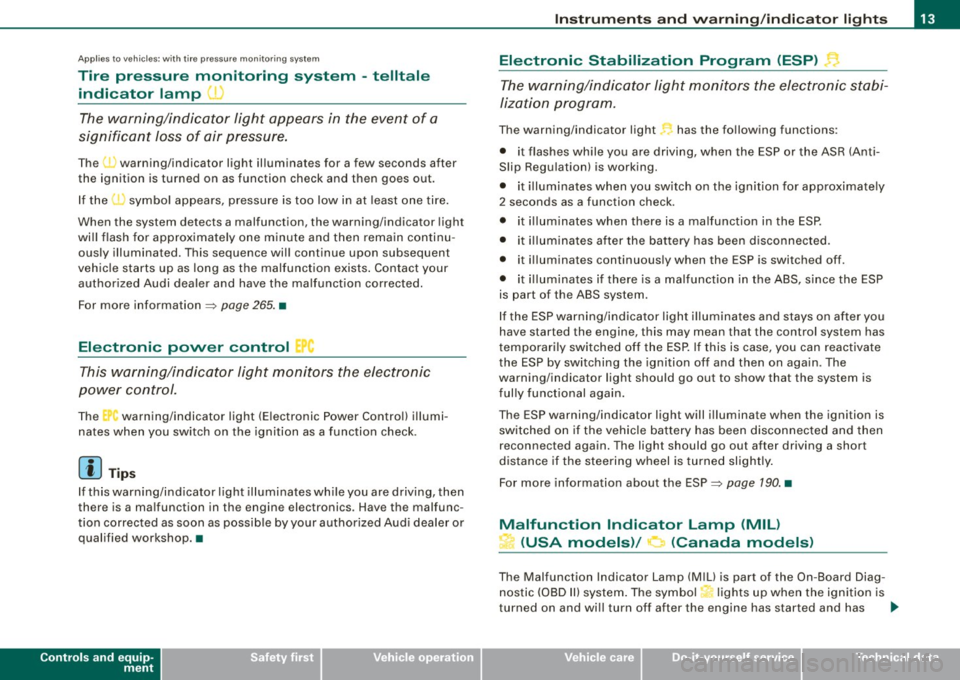
Applies to ve hicle s: w it h tir e pr essure mon itor in g system
Tire pressure monitoring system -telltale
indicator lamp
The warning/indicator light appears in the event of a
significant loss of air pressure.
The f warning/indicator light illuminates for a few seconds after
the ignition is turned on as function check and then goes out.
If the symbol appears, pressure is too low in at least one tire.
When the system de tec ts a malfunc tion, the warning /indicator light
wi ll flash for approximately one minute and then remain continu
ously illumina ted . This sequence wil l continue upon subsequen t
vehicle starts up as long as the malfunction exists . Contact your
authorized Audi dealer and have the malfunction corrected.
For mor e information =:>
page 265. •
Electronic power control
This warning/indicator light monitors the electr onic
power control.
The warning /indicator light (E lectronic Power Control) illumi -
nates when you switch on the ignition as a function check .
[ i ] Tips
If this warning/ind icator l ight il luminates whi le you are driving, then
ther e is a mal function in the engin e elec tronics . Have th e malfunc
tion corrected as soon as possible by your authorized Audi dealer or quali fied workshop. •
Controls and equip
ment
In st rum ent s a nd w arnin g/indi cato r ligh ts
Electronic Stabilization Program (ESP)
The warning/indicator light monitors the electronic stabi
lization program .
The warning/indicator light r has the fo llowing functions :
• it flashes wh ile you are driving, when the ESP or the ASR (Anti
Slip Regulat ion) is working .
• it illuminates when you switch on the ignition for approximate ly
2 seconds as a function check .
• it illuminates when there is a ma lfunction in the ESP.
• it illuminates after the battery has been d isco nnected.
• it illuminat es con tinuous ly when th e ESP is switch ed off .
• it illuminates if there is a malfunction in the ABS, s ince the ESP
is part of the ABS system.
I f the ESP warning/indicator light illuminates and stays on after you
have started the engine , this may mean that the control system has
tempo rarily switched off the ESP. If this is case, you can reactivate
the ESP by switching the ignition off and then on again . The
warning/indicator light should go out to show that the system is
f ul ly functional again.
Th e ESP warning/indica tor light will i lluminat e wh en the ignition is
switched on if the vehicle battery has been disconnected and then
reconnec ted again. The light should go out after driving a short
distance if the stee ring wheel is turned slightly .
For more information about the ESP=:>
page 190. •
Malfunction Indicator Lamp (MIL)
-ai (USA models) / (Canada models)
The Malfunction Indicator Lamp (MIU is part of the On-Board Diag
n ostic (OBD Ill system . The symbol
L lights up when the ignition is
turned on and wi ll tu rn off after the engine has started and has _,,
I • •
Page 17 of 324
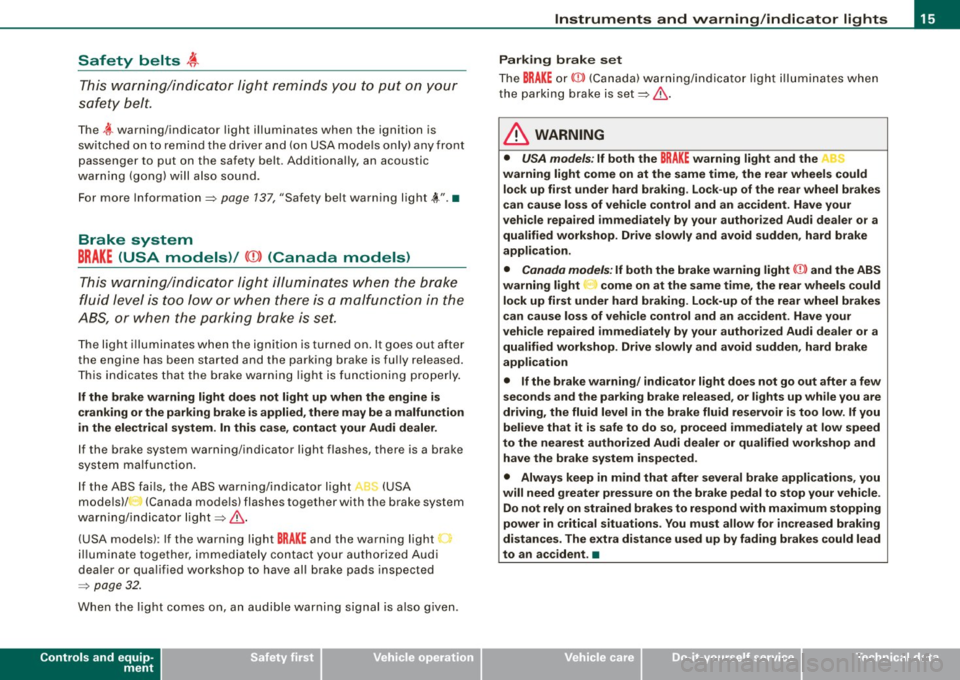
Safety belts i
This warning/indicator light reminds you to put on your
safety belt.
Th e ,{f. warning/indicator light illuminat es when the ignition is
switched on to remind the driver and (on USA models only) any front
passenger to put on the safety belt. Additionally, an acoustic
warning (gong) will also sound.
For more Information:::::, page 137, "Safety belt warning light-*-"·•
Brake system
BRAKE (USA models) / (CD) (Canada models)
This warning/indicator light illuminates when the brake
fluid level is too low or when there is a malfunction in the
ABS, or when the parking brake is set.
The light illuminates when the ignition is turned on. It goes out after
the engine has been started and the parking brake is fully released.
This indicates that the brake warning light is functioning properly.
If the brake warning light does not light up when the engine is
cranking or the parking brake is applied, there may be a malfunction
in the electrical system. In this case, contact your Audi dealer. If the brake system warning/indicator light flashes, there is a brake
system malfunction.
If the ABS fails, the ABS warning /indicator light (USA
models)/
.J (Canada models) flashes together with the brake system
warning/indicator light:::::,& .
(USA models): If the warning light
BRAKE and the warning light
illuminate together, immediately contact your authorized Audi
dealer or qualified workshop to have all brake pads inspected
=:> page 32.
When the light comes on, an audible warning signal is also given.
Controls and equip
ment
Instruments and warning/indicator lights
Parking brake set
The BRAKE or CCi)) (Canada) warning/indicator light illuminates when
the parking brake is set:::::,&.
& WARNING
• USA models : If both the BRAKE warning light and the
warning light come on at the same time, the rear wheels could lock up first under hard braking. Lock-up of the rear wheel brakes
can cause loss of vehicle control and an accident. Have your
vehicle repaired immediately by your authorized Audi dealer or a qualified workshop. Drive slowly and avoid sudden, hard brake
application.
• Canada models: If both the brake warning light CCi)) and the ABS
warning light come on at the same time, the rear wheels could
lock up first under hard braking. Lock-up of the rear wheel brakes
can cause loss of vehicle control and an accident. Have your
vehicle repaired immediately by your authorized Audi dealer or a
qualified workshop. Drive slowly and avoid sudden, hard brake
application
• If the brake warning/ indicator light does not go out after a few
seconds and the parking brake released, or lights up while you are
driving, the fluid level in the brake fluid reservoir is too low. If you
believe that it is safe to do so, proceed immediately at low speed
to the nearest authorized Audi dealer or qualified workshop and have the brake system inspected.
• Always keep in mind that after several brake applications, you
will need greater pressure on the brake pedal to stop your vehicle .
Do not rely on strained brakes to respond with maximum stopping
power in critical situations. You must allow for increased braking
distances. The extra distance used up by fading brakes could lead
to an accident. •
I • •
Page 18 of 324
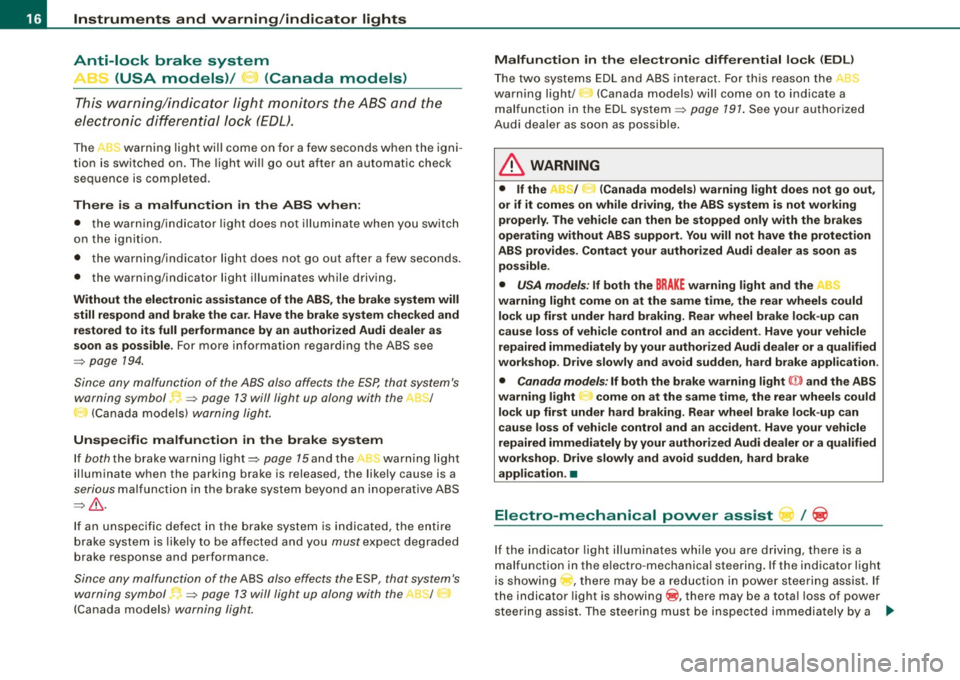
Instruments and warning/indicator lights
Anti-lock brake system
~ _ (USA models)/ .... (Canada models)
This warning/indicator light monit ors the A BS and the
electronic differenti al lock (EO L).
The ,I<-warning light wi ll come on for a few seconds when the igni
tion is switched on. The light will go out after an automatic check
sequence is completed.
There is a malfunction in the ABS when:
• t he war ning/in dicat or li ght does not illuminate when yo u switc h
on the ignition .
• th e warning/indicator l ig ht doe s no t go out after a few sec onds.
• the warning/indicator light illum inates while driving.
Without the electronic assistance of the ABS , the brake system will
still respond and br ake the car. Have the brake system che cked and
restored to its full performance by an authorized Audi dealer a s
soon as possible.
For more information regarding the ABS see
=> page 194 .
Since any malfunction of the ABS also affe cts the ESP, that system's
warning symbol •
=> page 13 will light up along with the A8~/
I':!. (Canada models) warning light.
Unspecific malfunction in the brake system
If bo th the brake warn ing lig ht=> page 15and the wa rn ing l ight
il luminate when the parking brake is released, the likely cause is a
serious m alfun ction in t he brake system beyond an inoperative ABS
=> & .
If an unspec ific defect in the brake sys te m i s indica ted, the e ntire
brake system is likely to be affected and you
must expect degraded
bra ke response and performance.
Since any malfunc tion of the ABS a lso effects the ESP, that system's
warning symbol ~=> page 13 will light up along with the ~1
J
(Canada models) warning light . Malfun
ction in the ele ctronic differential lock
(EDL )
The two syste ms E DL and ABS in te ract. F or th is rea son th e,. ::,
warning li ght/
~ (Canada mode ls) wi ll come on to ind icate a
m alf unctio n in the EDL system =>
page 191 . See your a uthor ized
Aud i dea ler as soon as poss ib le.
& WARNING
• If the / .t (Canada models} warning light does not go out ,
or if it comes on while driving , the ABS system is not working
properly . The veh icle can then be stopped only with the brakes
operating without ABS support . You will not have the protection
ABS provides. Contact your authori zed Audi dealer as soon a s
possible .
• USA models : If both the BRAKE warning light and the
warning light come on at the same time, the rear wheels could
lock up first under hard braking. Rear wheel brake lock -up can
cause loss of veh icle control and an accident . Have your vehicle
repaired immediately by your authorized Audi dealer or a qualified
workshop . Drive slowly and avoid sudden , hard brake application .
• Canada models : If both the brake wa rning light {(j)) and the ABS
warning light come on at the same time , the rear wheels could
lock up first under hard braking. Rear wheel brake lock -up can
cause loss of vehicle control and an accident . Have your vehicle
repaired immediately by your authorized Audi dealer or a qualified
workshop . Drive slowly and avoid sudden, hard brake
application. •
Electro-mechanical power assist / ~
If the i ndicator ligh t illum inates w hile you a re driving, ther e is a
malfunction in the e lectro -mechanica l steering . If the indicator light
is showi ng ....,, , ther e may be a r educ tion i n po w er s teerin g assist. I f
the indicator light is showing @, there may be a total loss of power
s teer ing assis t. The stee ring must be i nspec ted i mme diately by a ._
Page 57 of 324
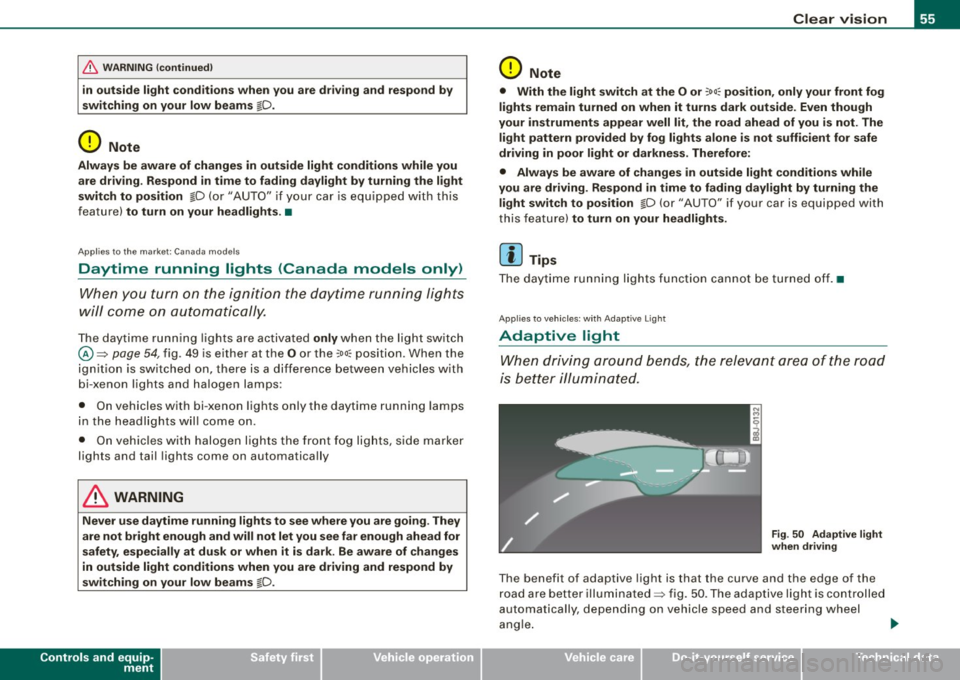
& WARNING (continued)
in outside light conditions when you are driving and respond by
switching on your low beams
io.
0 Note
Always be aware of changes in outside light conditions while you
are driving . Respond in time to fading daylight by turning the light
switch to position
io (or "AUTO" if your car is equipped with this
feature)
to turn on your headlights. •
Applies to the market: Canada models
Daytime running lights (Canada models only)
When you turn on the ignition the daytime running lights
will come on automatically.
The daytime running lights are activated only when the light switch
@=> page 54, fig . 49 is either at the O or the ;oo:c position. When the
ignition is switched on, there is a difference between vehicles with
bi-xenon lights and halogen lamps :
• On vehicles with bi -xenon lights only the daytime running lamps
in the headlights will come on .
• On vehicles with halogen lights the front fog lights, side marker
lights and tail lights come on automatically
& WARNING
Never use daytime running lights to see where you are going. They
are not bright enough and will not let you see far enough ahead for
safety, especially at dusk or when it is dark. Be aware of changes
in outside light conditions when you are driving and respond by
switching on your low beams
io.
Controls and equip
ment
Clear vision
0 Note
• With the light switch at the O or ooo:c position, only your front fog
lights remain turned on when it turns dark outside. Even though
your instruments appear well lit, the road ahead of you is not. The light pattern provided by fog lights alone is not sufficient for safe
driving in poor light or darkness. Therefore:
• Always be aware of changes in outside light conditions while
you are driving. Respond in time to fading daylight by turning the light switch to position
io (or "AUTO" if your car is equipp ed with
this feature)
to turn on your headlights.
[ i] Tips
The daytime running lights function cannot be turned off.•
Applies to vehic les : w ith Ada ptive ligh t
Adaptive light
When driving around bends, the relevant area of the road
is better illuminated.
Fig . 50 Adaptive light
when driving
The benefit of adaptive light is that the curve and the edge of the
road are better illuminated=> fig . 50 . The adaptive light is controlled
automa tically , depending on vehicle speed and steering wheel
angle. _,,,,
I • •
Page 59 of 324

Coming home situ ation
In darkness, the activated system will turn on the headlights, side
marker lights, rear side marker lights, toil lights, and rear license
plate light as soon as the driver's door is opened from inside.
As long as one of the doors or the rear lid remains open, the set of
external lights will keep burning for about four minutes maximum.
To provide light for departure, the set of vehicle lights will keep
burning for about another 30 seconds after all doors and the rear lid
have been closed .
The time until the lights are switched off can be adjusted~ page 23.
Leaving home situation
As soon as the vehicle is unlocked by pressing the en button on your
remote control, the set of external lights is switched on.
The external lights are switched off as soon as the driver's door is
opened from outside . Even if you had the system readjusted to keep
the lights burning for an extended time for coming home, the
external lights will be turned off if you do not open the driver's door
within 60 seconds after unlocking . See chapter "Opening and
Closing" in your Owner's Manual. If the lights are switched off
before you reach the driver's door, press the@ button once more to
turn them on again .
[ i J Tips
• Do not attach any stickers to the windshield in front of the two
light sensors, as this would interfere with both the automatic oper
ation of the head lights and the automatic dimming of the inside
mirror(sl.
• If the vehicle is remotely unlocked and locked three times in
succession, leaving home will not turn on the lights a fourth time to
safeguard the battery and lights.
• If you wish to use the coming home/leaving home function regu
larly, you can leave it activated at all times without risking perma-
Contro ls and eq uip
ment
Clear vision
nent strain on the electrical system. As the system is controlled by
light sensors, it wi ll only be energized in darkness.
• Frequent use of the coming home/leaving home function for
approaching and departing a vehicle parked in the dark will strain
the battery . This applies particularly if only short distances are
driven between stops. Occasionally drive longer distances to make
sure the battery is recharged sufficiently .
• If the fog lights have been switched on by the coming
home/leaving home function, they will always be switched off when
you switch on the ignition .•
Instrument panel illumination
The illumination of the instruments, displays and the
center console can be adjusted.
"' ;
-a'.. co
"'
li8t ey)
Fig . 53 Instrument
panel illumination
You regulate the brightness of the instruments with the left
thumbwheel
<,;"o/ => fig. 53.
Ign ition ON, light switch at @.
With the ignition switched ON, the glow of instrument needles can
be adjusted to appear brighter or dimmer.
1)1,
Vehicle care I I irechnical data
Page 61 of 324

Turn signals -¢ Q and high beam ~D lever
The lever on the left side of the steering column is used to
operate the turn signals and the high beam as well as the
headlight flasher.
Fig . 55 Turn signal and
high beam lever
The turn signal and high beam lever has the following func
tions:
Turn signals ¢ ¢
- Lift the lever up all the way~ fig. 55 G), to use the right
turn signals, or push the lever down all the way
0 to use
the left turn signals.
Auto-blink
- Move the lever (up or down) just to the point of resis
tance to use the turn signals for as long as you need
them, for example when changing lanes.
- Briefly move the lever up or down just to the point of
resistance and then release it to flash the turn signals
three times in succession. This feature allows to indicate
lane changes clearly and with minimum effort when
driving on highways.
Con tro ls and eq uip
ment
Clear vision
High beam
~D
- Push the lever forward 0 to switch on the high beam.
- Pull the lever back towards you to switch off the high
beam .
Headlight flasher ~D
Pull the lever toward the steering wheel © to use the
headlight flasher.
Notes on these features
• The turn signals only work with the ignition switched on. The
indicator lights¢ or¢ in the instrument cluster=> page 11 also
blink.
• After you have turned a corner, the turn signal switches off auto
matically .
• The high beam works only when the headlights are on. The indi
cator light ~Din the instrument cluster illuminates when the high
beams are on.
• The headlight flasher works only as long as you hold the lever -
even if there are no lights switched on. The indicator light ~D in the
instrument cluster illuminates when you use the headlight flasher.
0 Note
Do not use the high beam or headlight flasher if you know that these
could be blinding oncoming traffic.•
Vehicle care I I irechnical data
Page 66 of 324
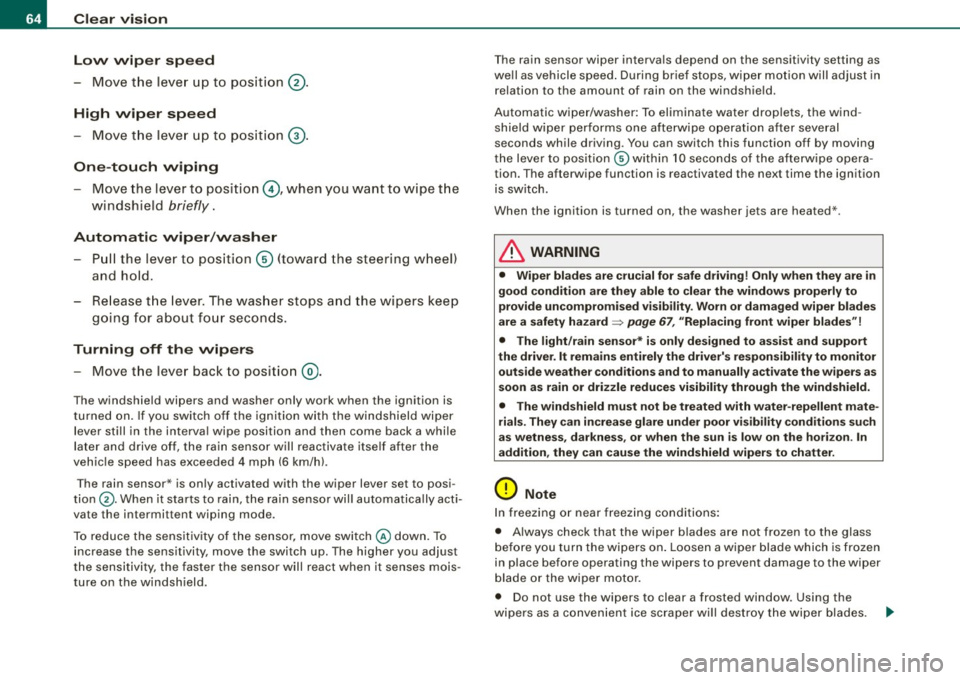
Clear vision Low wiper speed
- Move the lever up to position @ .
High wiper speed
- Move the leve r up to pos ition G) .
One-tou ch wiping
Move the lever to position@, when you want to wipe t he
windshield
briefly .
Automatic wip er/ wash er
- Pull the lever to pos ition G) (toward the steering wheel)
and hold.
- Re lease t he lever . The was her stops a nd the wipers keep
g o ing for about fo ur secon ds.
Turning off th e wipers
- Move the lever back to position @.
The windshield wipers and washer only work when the ignition is
turned on . If you switch off the igni tion with the windshield wiper
lever still in the interva l wipe position and then come back a while
la ter and drive off, the rain sensor w ill reactiva te itse lf afte r the
veh ic le speed has exceeded 4 mph (6 km/hl.
The rain sensor* is only activated with the wiper lever set to posi
tion ®· When it starts to rain, the rain sensor wil l automatica lly acti
vate the intermittent wiping mode.
To reduce the sensitivity of the sensor, move switch @down. To
increase the sensitivity, move the switch up. The higher you adjust
the sensitivity, the faster the sensor will react when it senses mois
ture on the windsh ield. T
he rain sensor wiper interva ls depend on the sensitivity setting as
we ll as vehicle speed . During brief stops, wipe r mo tion will adjust in
relation to the amount of rain on the windshield.
Automatic wiper/washer: To eliminate water drop lets, the wind
shield wiper performs one afterwipe operat ion after several
seconds while driving. You can switch this function off by moving
t he lever to posit ion © within 10 seconds of the afterwipe opera
tion. The afterwipe function is reactivated the next time the ignition
is switch.
When the ignition is turned on, the washer jets are heated *.
& WARNING
• Wiper blade s are crucial for safe driving ! Only when they are in
good condition are they able to clear the window s properly to
provide uncompro mised v is ib ility. Worn or dam aged wiper bl ades
are a safety hazard =>
page 67 , "Replacing front wiper blade s"!
• The light /rain sen sor * is on ly de signed to a ssis t an d suppo rt
the driver . It remains en tirely the dr iver' s re spon sibility to monitor
out side weather cond ition s and to manuall y activate the wiper s as
s oon a s rain or dri zzle reduces visibility through the wind shield .
• The wind shield mu st not be t re ate d with water -r e pellent mat e
rial s. They can increa se glare under po or vi sibilit y conditions su ch
a s w etne ss, dar kne ss, or whe n the sun is lo w on t he hori zon . In
addition , they can cau se the windshield wipers to ch atter .
0 Note
In freezing o r near freez ing conditions:
• Always check that the wiper blades are not frozen to the glass
b efore you turn the wipers on . Loosen a wipe r blade which is fr ozen
in place before operating the wipers to prevent damage to the wiper
b lade or the wiper motor.
• Do not use the wipers to clear a frosted window . Using the
wipers as a conven ient ice scraper wi ll dest roy the wiper blades. .._
Page 76 of 324
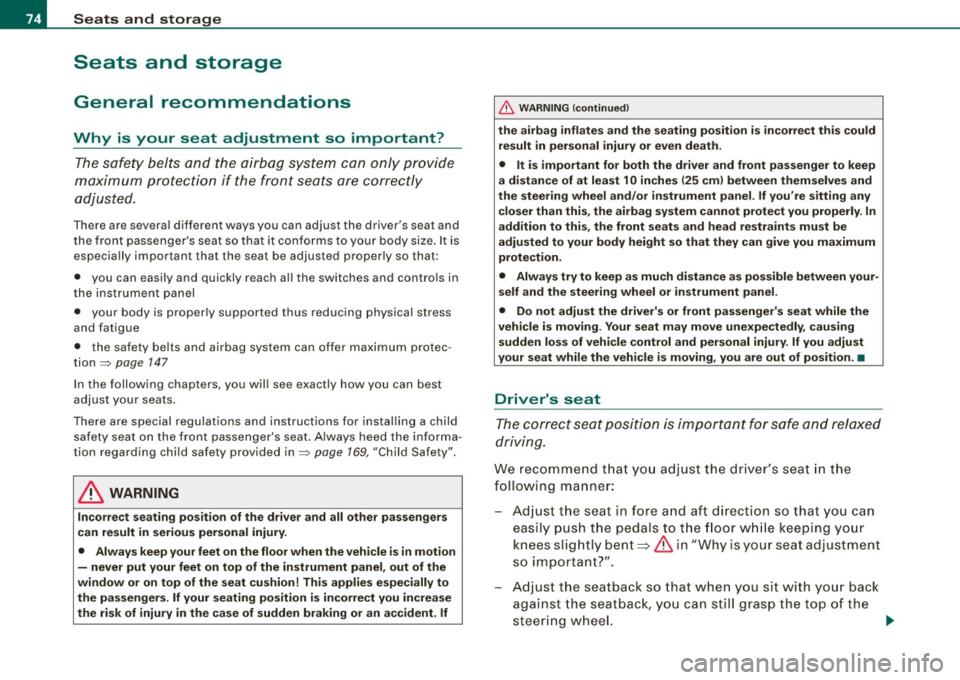
Seats and storage
Seats and storage
General recommendations
Why is your seat adjustment so important?
The safety belts and the airbag system can only provide
maximum protection if the front seats are correctly
adjusted.
There are several different ways you can adjust the driver's seat and
the front passenger's seat so that it conforms to your body size. It is
especially important that the seat be adjusted properly so that:
• you can easily and quickly reach all the switches and controls in
the instrument panel
• your body is properly supported thus reducing physical stress
and fatigue
• the safety belts and airbag system can offer maximum protec
tion=>
page 147
In the following chapters, you will see exactly how you can best
adjust your seats.
There are special regulations and instructions for installing a child safety seat on the front passenger's seat. Always heed the informa
tion regarding child safety provided in=>
page 769, "Child Safety".
L1}. WARNING
Incorrect seating position of the driver and all other passengers
can result in serious personal injury.
• Always keep your feet on the floor when the vehicle is in motion
- never put your feet on top of the instrument panel, out of the
window or on top of the seat cushion! This applies especially to
the passengers. If your seating position is incorrect you increase
the risk of injury in the case of sudden braking or an accident. If
& WARNING (continued)
the airbag inflates and the seating position is incorrect this could
result in personal injury or even death.
• It is important for both the driver and front passenger to keep
a distance of at least 10 inches (25 cm) between themselves and
the steering wheel and/or instrument panel. If you're sitting any closer than this, the airbag system cannot protect you properly. In
addition to this, the front seats and head restraints must be
adjusted to your body height so that they can give you maximum
protection.
• Always try to keep as much distance as possible between your
self and the steering wheel or instrument panel.
• Do not adjust the driver's or front passenger's seat while the
vehicle is moving . Your seat may move unexpectedly, causing
sudden loss of vehicle control and personal injury. If you adjust
your seat while the vehicle is moving, you are out of position. •
Driver's seat
The correct seat position is important for safe and relaxed
driving.
We recommend that you adjust the driver's seat in the
following manner:
- Adjust the seat in fore and aft direction so that you can easily push the pedals to the floor while keeping your
knees slightly bent=>
& in "Why is your seat adjustment
so important?".
- Adjust the seatback so that when you sit with your back
against the seatback, you can still grasp the top of the
steering wheel.
~